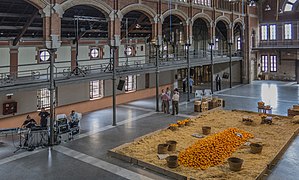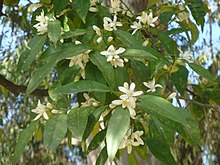Orange fruit)
The orange is a citrus fruit obtained from the sweet orange (Citrus × sinensis), bitter orange (Citrus × aurantium) and orange trees of other varieties or hybrids, of Asian origin. It is a fleshy hesperidium with a more or less thick and hardened skin, and its pulp is typically made up of eleven segments or skins full of juice, which contains a lot of vitamin C, flavonoids and oils. essential. It is cultivated as an ancient ornamental tree and to obtain fragrances from its fruits. It is smaller and sweeter than the grapefruit or grapefruit and larger, although less scented than the tangerine. There are numerous varieties of oranges, the majority being hybrids produced from the species Citrus maxima (pamplemusa), Citrus reticulata (mandarin) and Citrus medica (citron).
According to the FAO, in 2014 world fruit growing produced some 71 million tons of this citrus, a quarter coming from Brazil and the rest from China, India, Mexico, the United States, Spain, Egypt, Indonesia, Turkey and others countries.
Etymology
The Spanish word "naranja" comes from the Sanskrit narang (नारंग), however, it is not a native word to that language but it is speculated that it took it from Dravidian languages such as Tamil where we say narandam (நரந்தம்) for 'bitter orange', nagarukam (நாகருகம்) for 'sweet orange', being nari (நாரி) 'fragrance'. The word along with the fruit was slowly carried westwards: from Sanskrit it passed into Persian (nārensh نارنج), then into Arabic (naranj (نرنج), the tree, and orangeh نرنجة, the fruit) and from there to Spanish "naranjo" and "naranja", respectively.
It spread to other European languages in a curious process: the Portuguese changed the initial ene to an ele (orange), when moving to Italian so that the initial ele would not overlap with the article «la » the initial ele (arancia) was dropped, while in French and Latin it was associated with the lexeme oro (or and aurum) resulting in orange and aurantium. Because in the Middle Ages the learned language of England was French, in English it passed as orange. We always talk about Citrus × aurantium, with a bitter taste, the only orange known in the Middle Ages in Europe.
Later, a drastic change would occur and that is that with trade with the Indies, Portugal brought in the XVI century the Citrus × sinensis and Citrus reticulata, with a sweet taste. First called in Spanish respectively "China orange" and "mandarin orange" or "tangerine", the Citrus sinensis ended up taking the name of "orange" to dry, previously reserved for the aurantium , which came to be called "bitter orange." In some parts of Mexico and the Caribbean, the (sweet) orange is still called "Chinese orange." In Puerto Rico and some cities in the Dominican Republic it is known simply as "china". Citrus reticulata gradually lost the name "orange" until it was simply "mandarin", which is why it is not usually considered an orange.
Varieties
Sweet Orange
There would be four basic types of sweet orange, each with different varieties: navel, white (Salustiana, Parson Brown, Pineapple, Cadenera, Hamlin, Pear, Valencia orange, Midnight, Delta Seedless, or Late Frost, Don Jöao, Barberina and Folha Murcha), blood (Moro, Sanguinelli, Tarocco Rosso) and sucreñas (Lima, Succari and Sucreña).
Persian Orange
The Persian orange, widely cultivated in southern Europe after its introduction to Italy in the 11th century, was bitter. The sweet orange was brought from China in the 15th century by Portuguese traders, quickly replaced the bitter one, and today it is the most commonly cultivated variety. The sweet orange grows in different sizes depending on local conditions, commonly with ten wedges, skins or segments, inside.
Portuguese, Spanish, Arab, and Dutch sailors planted citrus trees along trade routes to prevent scurvy. On his second voyage in 1493, Christopher Columbus brought orange seeds and lemons to Haiti and the Caribbean. They were introduced to Florida (along with lemons) in 1513 by Spanish explorer Juan Ponce de León, to California by the Franciscans along the Camino Real de California in the second half of the century XVIII and in Hawaii in 1792.
Navel Orange
A unique mutation that occurred in 1820 in a sweet orange orchard of a Brazilian monastery led to the "navel orange", also known as "shore orange". The mutation caused a second, small and atrophied orange to develop at the base of the fruit, giving it the appearance of a navel. From this variety, identified in commercial terms with the English word navel ('navel'), others have been derived, such as the «navelina», a hybrid with an easy-to-peel rind, and the «navelate» or late navel. It is also often called "California orange." It should be noted that the "navelate" variety is considered by professionals and consumers as the best variety of orange in the world due to its organoleptic properties.
Valencia Orange
The Valencia orange (in English Valencia late: 'late Valencia'), has its origins in 19th century California XIX, is one of the sweet varieties used in Spain for juice extraction. Due to having its season after other oranges, its consumption is popular after the navel season has passed. Despite its name, this variety has no relationship of origin with the Valencian Community, although it is one of the most cultivated varieties in it, along with the navel and navelina. It has a characteristic size, and a large amount of juice which can sometimes be slightly acidic. It is part of the white variety oranges, so called because its color is not so intense.
It is also not related to the city of Valencia in Venezuela, despite the fact that in this country the Carabobo state is characterized by its orange production.
Salustian Orange
The Salustiana orange is a variety of the White orange and was produced by a spontaneous mutation in the province of Valencia due to its climate and growing conditions. It is a typically Spanish orange.
In the same way as the Valencia, it does not have the reddish orange color that the navelinas have. Their shape is also somewhat different, since they tend to have a more flattened shape. Its skin is also thinner than other varieties, and its size is usually medium. Its strong point is its large amount of juice. This, together with its intense sweet flavor, makes them perfect to consume in the form of juice. The Salustiana orange is very sensitive to cold, which is why its optimal period is from February to the middle or end of March, which is when the temperature in the province of Valencia begins to rise and the nights are no longer so cold.
Chain Orange
The fruit of the Cadenera orange is large, spherical in shape, slightly flattened, and its pulp has a high content of juice with a very sweet flavor. It comes from the fertile plain of Palma del Río, in the province of Córdoba. This area has excellent climatic conditions, and has a long tradition of citrus crops.
Blood Orange
Blood oranges have red stripes on the skin, and the juice is often burgundy. The fruit has made a place for itself as an interesting ingredient variation on the traditional Seville jam, with its striking red stripes and distinct flavor. The "scarlet navel" is a variety with the same diploid mutation as the navel orange.
Production
Oranges for commercial production are grown in orange groves throughout the world, although the three largest producers are Brazil, the United States and Mexico. Oranges are very sensitive to frost, a common treatment when freezing temperatures are forecast is to water the trees with water so that while the water turns to ice on the tree branches, the newly formed ice stays at its set point. freezing and protect in case the air temperature drops much below zero degrees.
| Countries | 2000 | 2005 | 2009 | |||
|---|---|---|---|---|---|---|
| Brazil | 21 330 300 | 17 853 400 | 17 618 500 | |||
| United States | 11 790 700 | 8 393 270 | 8 280 780 | |||
| India | 2 674 700 | 314 000 | 5 201 350 | |||
| China | 1 180 631 | 2 740 927 | 4 864 959 | |||
| Mexico | 3 812 680 | 4 112 710 | 4 193 480 | |||
| Iran | 1 843 560 | 2 253 210 | 2 713 240 | |||
| Spain | 2 616 220 | 2 376 230 | 2 617 700 | |||
| Italy | 1 876 180 | 2 261 400 | 2 359 400 | |||
| Egypt | 1 610 520 | 1 789 000 | 2 200 000 | |||
| Indonesia | 644 052 | 2 214 020 | 2 102 560 | |||
| Turkey | 1 070 000 | 1 445 000 | 1 689 920 | |||
| Pakistan | 1 328 000 | 1 721 000 | 1 492 400 | |||
| South Africa | 1 169 810 | 1 246 450 | 1 445 300 | |||
| Morocco | 870 000 | 835 000 | 1 200 000 | |||
| Global total | 63 793 124 | 62 832 014 | 68 475 267 | |||
| Source: Food and Agriculture Organization of the United Nations. | ||||||
Nutritional information
Like all citrus fruits, oranges are acidic, with a pH between 3.1 and 4.1 depending on the ripeness, size and variety of the piece. Although this is not, on average, as strong as lemon, it is still as strong on the pH scale as vinegar. Thanks to its simple sugar content, the acid flavor does not stand out as much as it can happen in grapefruit. The component that has caused the most talk about the orange is its vitamin C, since 100 g of the product contain up to 90% of the daily needs, however, it also contains non-nutritive substances, including the presence of phytochemicals., such as flavonoids (with antioxidant, anti-inflammatory and antitumor effects) and limonoids (anticancer).
Cultural references
An orange was chosen as the mascot for the 1982 Soccer World Cup, held in Spain. The character was called "Naranjito", and he wore the uniform of the host soccer team.
Naranjito is also a town in Puerto Rico, located in the center of the island.
In Francis Ford Coppola's The Godfather film saga, oranges are a symbol of death and betrayal.
Contenido relacionado
Monocarpy
Egg
Ustilaginomycetes






